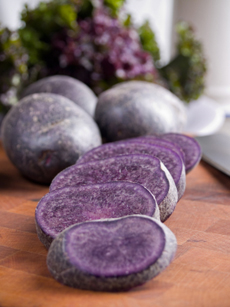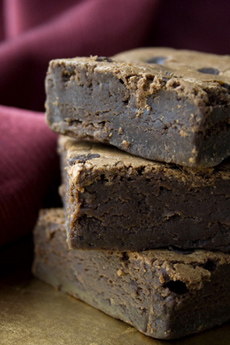|
It’s National Potato Month.
Millennia ago, potatoes grew wild in the foothills of the Andes Mountains of Peru. They were cultivated around 3,000 B.C.E. by the Incas and discovered by Europeans when the Spanish conquistadors reached the shores of Montezuma’s empire (modern-day Mexico) in 1519.
Now a staple in many national cuisines, potatoes are the third most important food crop in the world (preceded by rice and wheat). Hundreds of different varieties are grown globally.
The different varieties range from the size of a grape to the size of a grapefruit. Potatoes come in many shapes, from round to oval to twisted. While most Americans have seen only white potatoes and sweet potatoes, there are varieties in a rainbow of colors: black, blue, brown, green, orange, pink, purple, yellow and the ubiquitous white potato.
Specialty markets often carry blue and purple varieties. Check farmers markets for the more unusual potato varieties.
|
|

Purple Peruvian potatoes, a delight at the
table. Photo by Mona Makela | IST. |
Even among white potatoes, the texture and flavor vary widely—from the Russet potato most commonly used for baking, to fingerlings and Yukon Golds. The creamy flesh and delicate flavors are analogous to tasting different types of oysters: There’s a commonality, but enough of a difference so that each of us can develop clear preferences.
For National Potato Month, try different varieties.
Check local markets or look on Melissas.com. If you see something different, buy it. That’s how we discovered Russian banana potatoes.
Browse through our Potato Glossary. You’ll find types of potatoes and famous potato dishes that are begging you to celebrate National Potato Month.
The Potato Glossary also has cooking, nutrition and potato storage information.
|





